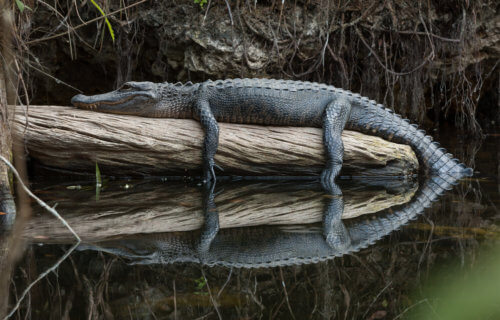
TEMPE, Ariz. – Young alligators can regrow their tails if they get cut off, a new study reveals. Now scientists hope that their findings can support research into future therapies for humans who have suffered traumatic injuries.
Researchers have long known that small reptiles, such as lizards, can regrow all or part of their tails and sometimes even their feet, but have only now discovered that their giant cousins can do the same. However, unlike some reptiles, which can regenerate an entire tail or limb exactly the same as it was before it was amputated, alligators replace their tails without muscle.
Using X-rays and an MRI machine, a team from Arizona State University and the Louisiana Department of Wildlife and Fisheries analyzed the new tails to find that bone was replaced by a cartilage tube, while muscle was swapped for connected fibers. The team found blood vessels and nerves also regenerated.
“Regrowth of cartilage, blood vessels, nerves, and scales were consistent with previous studies of lizard tail regeneration from our lab and others,” says study lead author Dr. Cindy Xu, from ASU’s molecular and cellular biology program, in a university release. “However, we were surprised to discover scar-like connective tissue in place of skeletal muscle in the regrown alligator tail. Future comparative studies will be important to understand why regenerative capacity is variable among different reptile and animal groups.”
Despite finding four young alligators with regrown tails, it is still not clear whether adult alligators have the same ability as other species that can regenerate in childhood as well as when they’ve grown up.
Alligators, lizards, and humans all belong to a group of animals with backbones called amniotes. While the team has previously studied the ability of lizards to regenerate their tails, this finding of regrowth of complex new tails in the alligator gives further information about the process in amniotes. Because various species have the ability to regrow lost body parts, the discovery has also prompted the researchers to wonder how and when the ability arose during evolution.
“The ancestors of alligators and dinosaurs and birds split off around 250 million years ago. Our finding that alligators have retained the cellular machinery to regrow complex tails while birds have lost that ability raises the question of when during evolution this ability was lost. Are there fossils out there of dinosaurs, whose lineage led to modern birds, with regrown tails? We haven’t found any evidence of that so far in the published literature,” says Kenro Kusumi, professor and director of ASU’s School of Life Sciences and associate dean in the College of Liberal Arts and Sciences.
But apart from unraveling the mysteries of the past, the researchers hope their discovery can unlock treatments for humans recovering from injuries or suffering from diseases like arthritis in the future. “If we understand how different animals are able to repair and regenerate tissues, this knowledge can then be leveraged to develop medical therapies,” adds Rebecca Fisher, co-author and professor with the University of Arizona College of Medicine-Phoenix and ASU’s School of Life Sciences.
The study is published in the journal Scientific Reports.
